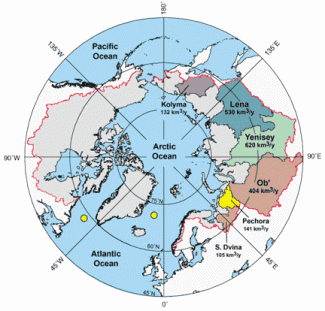Arctic Summer: Ships Set Sail through the Northern Sea Route
There is good news from the Arctic for the shipping industry. According to data released by the Northern Sea Route Administration, the nodal agency of the Russian Federal Government, which manages the Northern Sea Route (NSR), 330 applications from ships have been received since April 2013 informing the agency of their plans to transit through the NSR this summer. Of these, 213 applications were approved and 51 rejected. The reasons for the rejection of applications and the fate of the balance of 66 applications have not been made public. The bulk of the permitted vessels appear to be of Russian companies, but a number of ships flagged in Norway, Panama, Bahamas and France have planned voyages through the NSR. Last year, vessels under the flags of Panama, Liberia, and the Marshall Islands also transited through the NSR, reflecting the growing international nature of Arctic shipping.
These numbers compare favourably to the NSR sailings in the earlier years. In 2010, only four vessels took a voyage, and the number increased to 34 in 2011. Last year, 46 vessels transited through the NSR, including an LNG tanker which sailed from Hammerfest, Norway, to Tobata, Japan, covering nearly a thousand miles and saving almost 20 days of transit time. The number of transits through the NSR has significantly improved the cargo volume from 0.800 million tons in 2011 to 1.30 million tons in 2012. It is estimated that the cargo volume through the NSR could increase nearly ten times to 19 million tons by 2021.
Good news is also available for energy-hungry Asian countries. The forecast suggests that nearly 25 million tons of oil and LNG extracted from the Russian Arctic could be transported through the NSR by 2021. Likewise, container traffic through the NSR would be economically attractive between 2030 (1.4 million TEU [twenty-foot equivalent unit] in 480 transit voyages) and 2050 (2.5 million TEU in 850 transit voyages).
In essence, cargo trade between Asia and Europe through the NSR is expected to increase. According to South Korea’s Maritime Institute, the NSR ‘could account for a quarter of Asia-Europe trade by 2030.’ The above figures indicate that the future of shipping through the Arctic looks bright, and the route could be open for almost eight months a year.
However, there are a number of risks and challenges for the shipping industry. First, the Arctic region is known for extreme weather conditions, floating ice, fog, fierce winds, seasonal darkness, remoteness and poor accessibility. Second, there are limited passage support systems such as navigational aids, charts, communication systems, search and rescue (SAR) facilities and accident/distress response arrangements. Russia has drawn plans to put in place a number of safety measures to ensure the safe transit of ships and provide security cover to ships in distress. At the same time, the fear of an accident/oil spill in the pristine Arctic environment could be a disaster for the future of the NSR. The International Maritime Organisation (IMO), an arm of the UN, has established ‘Guidelines for ships operating in Arctic ice-covered waters’.
Third, the environmental impact of increased shipping activity in the Arctic merits inquiry. The increased shipping would naturally result in a greater human and commercial footprint with adversarial impacts on the marine habitat and indigenous people. Likewise, the cruise ship industry is actively engaged in the Arctic, and during the peak season, as many as eight liners sail a week between Greenland and Spitsbergen Island. Notwithstanding their strict adherence to ship discharges, the ships let out engine exhaust effluents, adversely impacting the environment.
Fourth, there are only three major Arctic ports: Churchill (Canada), Murmansk (Russia), and Prudhoe Bay (US). In 2012, Iceland announced plans to build a new port at Finna Fjord, which will be ‘free of ice all year round’ due to the warm Gulf Stream.
Since most of the NSR runs through the Russian Arctic, the Northern Sea Route Administration provides services to ensure that it is safe and secure for global traffic. A number of robust measures to respond to search and rescue (SAR), accident/distress calls, oil spills, and dissemination of the prevailing hydro-meteorological and ice conditions in the NSR are being developed.
The shipping activity in the Arctic is expected to grow in the coming years and offer opportunities to a number of businesses, including shipbuilders, energy and metal companies, freight forwarders and ancillary industries related to shipping. Also, as the cargo volumes increase, the freight costs will be reduced, further adding to the attractiveness of the NSR. Several Asian countries, particularly China, Japan and the Republic of Korea, can be expected to integrate NSR into their marine transportation strategies.
